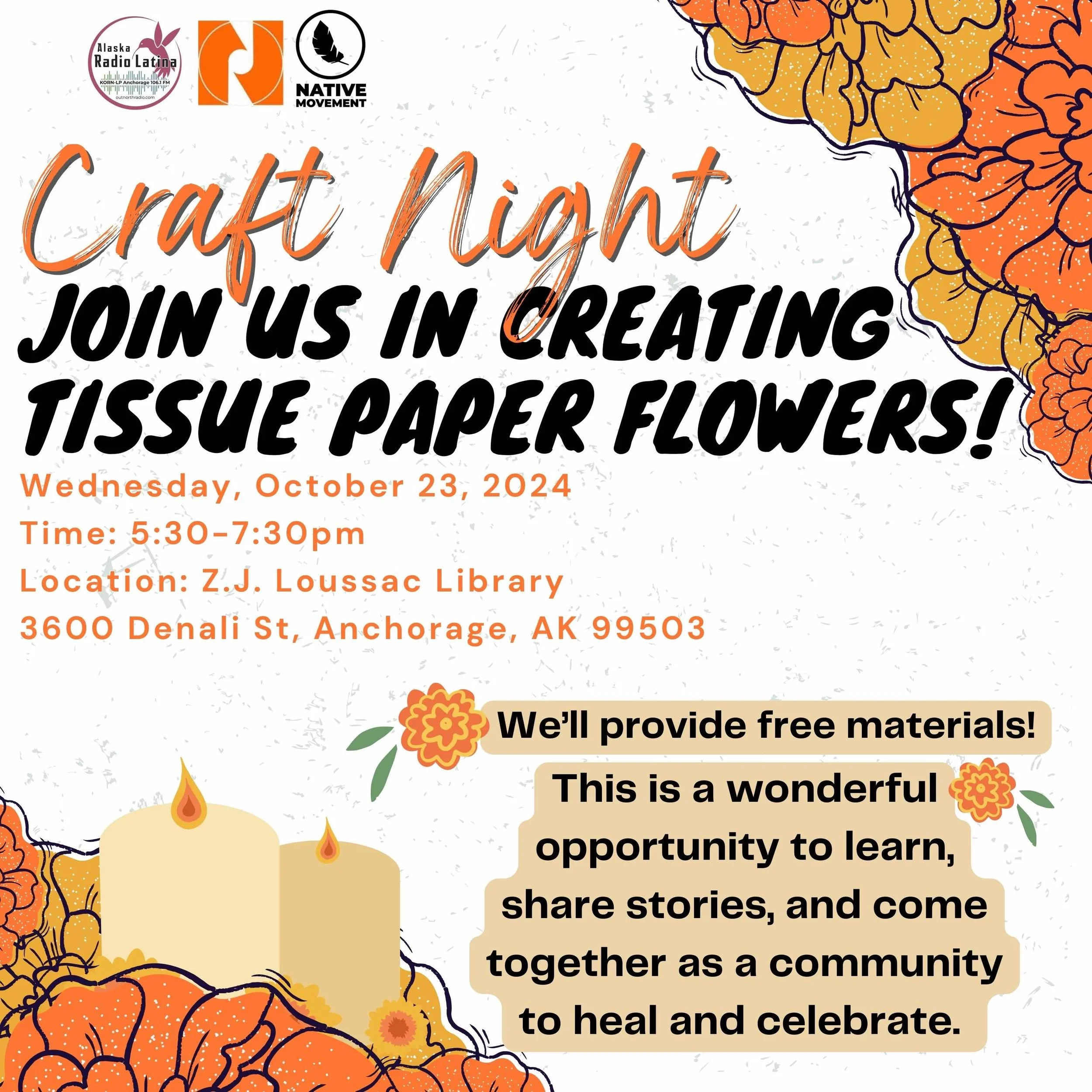Transcending Thinly Veiled Borders
Photos by Oliviah Franke
October 22nd, 2024 | Written By: Oliviah Franke
This year Anchorage is celebrating its 20th year of public Dia de Muertos (Day of the Dead) events, hosted this year by Out North and Radio Latina. Dia de Muertos is a holiday and ceremony rooted in Indigenous practices that honors our loved ones who have passed by welcoming their spirits to visit with us during a time when the veil between our worlds is thinnest. Ofrendas (offerings usually in the form of altars) are built with photographs, cempasuchil (marigolds), copal (an organic resin incense), papel picado (the intricately carved rainbow flags), water, salt, calaveras (decorative skulls), and pan de muerto (bread of the dead). All efforts are made to welcome our loved ones back with comfort and love, making sure that their favorite things are plentiful. At its core, Dia de Muertos is a celebration filled with joy and solemn awareness of life’s impermanence. Ceremony roots us in our connection to the spirit world and to mama pacha (the land).
Photos by Oliviah Franke
The belief that our ancestors and loved ones who have died are visiting with us in this living realm is deeply rooted in our Indigenous spirituality. Dia de Muertos has braided themes from Indigenous practices as well as Catholic influence from colonization. By integrating and adopting catholic symbols and ideas, Dia de Muertos has been able to persist and maintain its importance to culture across Abya Yala (1). The origins of Dia de Muertos are in Mexico and other parts of central Abya Yala.
________________________________________________________
1. Abya Yala is a name strongly supported by Indigenous peoples of the south to replace the word “America”. Abya Yala was the name the Cuna Indigenous people gave to the entire continent, meaning a ‘mature land’, or one that is bountiful. (Raices, El México Indigena en Alaska. Second Edition, Zagal et al. 2024).
Of course, there are celebrations across the world as our people find themselves spread out across lands, and we have found and cultivated a strong community here in Anchorage that have held this ceremony and celebration. Today there are many observances and protocols that vary greatly by region and person.
The kaleidoscope of Dia de los Muertos is made up of as many lenses as there are people that honor and celebrate. Some folks observe multiple days leading up to November 2nd, including a day to specifically honor children who have died (Dia de los Angelitos). Celebrating Dia de Muertos is a reclamation of our power and culture, an honoring of our community and identity. Our relationship to death is defined by this celebration and in our gathering, laughing, eating, singing, and dancing together.
For twenty years, we have been celebrating our ceremony and celebration on Dena'ina Ełnena. The Indigenous people of Abya Yala have always been connected, the threads of our stories interwoven across geography through the trading and gifting of what is most precious to us; songs, beads, clothing, prayers, language, and ways of being. There is a prophecy from relatives from the Amazon region that tells of the Eagle and Condor people. This spring our team was invited to support the start of the 2024 Peace and Dignity Journey in Fairbanks, where this prophecy was shared with us. The prophecy describes the separation of Eagle People of the north and Condor People of the south, characterized by masculine and feminine energies, respectively. The prophecy says that the Eagle people will become powerful and domineering, but ultimately there is a call for reconciliation, to ‘fly in the same sky’ and bring new levels of consciousness for humanity.
Photos by Oliviah Franke
In our work at Native Movement we tend to many things, and the continued tending to the threads that connect people from across Abya Yala, the Eagle and the Condor people, is an important component for working towards a liberated and thriving future for the people of Dena’ina Elnena. Our prosperity and the future in which we thrive is intertwined with the successes and struggles of the Indigenous people of Alaska. We must intentionally tend to our connections, to our ways of being, and share in reciprocity. We must gather and share in our grief, our joys, our celebrations, and when invited- our ceremonies.
As a person whose ancestors are from the lands now known as Sinaloa and Sonora Mexico, it is a gift to honor and celebrate Dia de Muertos as a visitor on these Dena’ina lands. Recognizing our loved ones who have died, while being in community helps us move through the hard parts of grief. But amongst those parts are also the joyful parts of grieving: sharing of stories and jokes, the connection and empathy that we can build for one another, and the taking up of space. Opening the doors of our culture to others and reaching across differences to share in this celebration together is done with reverence for the Indigenous people of these lands, as well as being a generous showing of trust and community. While our identities and cultures may present social divides, Dia de Muertos collaborations with the Native Movement team and community is a reaching across that thinly veiled divide, and our healing becomes collective.
Photos by Oliviah Franke
We heal from the impacts of colonization and the erasure of our people and cultures. We heal from the violence that our people experience, through the heartache of generations lost, and we heal through the joy of knowing that our ancestors are now friends, as they visit us and each other while enjoying the finest things we can offer them.






